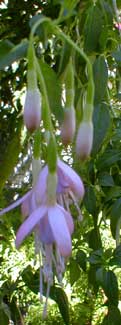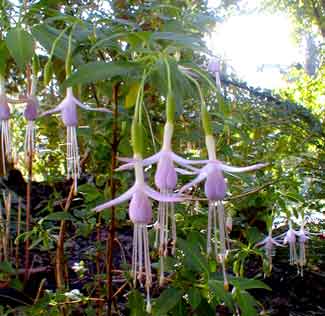
"Maiden's Blush," "Alba,"
or "Molinae" Ladies' Eardrops;
aka White Hardy Fuchsia
"He was struck by the dignity of her carriage. Her
bare arms lay gracefully beside her slender waist;
gracefully some light sprays of fuchsia drooped from
her shining hair on to her sloping shoulders."
-Father's & Children,
Ivan Turgenev
(1818‚1883)
Ivan Turgenev
(1818‚1883)
Granny Artemis started us collecting hardy fuchsias. I remember the first one she obtained was a wee four-inch pot of Fuchsia magellanica gracilis 'Aurea' which rapidly became a substantial fountaining shrub. We've added several since. The beauty of the foliage & the staying-power of the blossoms are traits that are hard to beat.
Shown here is F. magellanica var. molinae the Maiden's Blush Fuchsia. Why it was formerly called 'Alba' (or 'White Fuchsia') is beyond me. It does have white sepals but the corrolla dominates in palest lavender-pink. In recent years the variant (or forma) name 'Molinae' has supplanted 'Alba.'
 A variant is a naturally occuring distinct race of a species, which does not quite meet the qualifications of a subspecies. This particular variant of the South American species is native of Columbia.
A variant is a naturally occuring distinct race of a species, which does not quite meet the qualifications of a subspecies. This particular variant of the South American species is native of Columbia.Yet 'Molinae' now commonly serves the function of a cultivar name rather than scientific name. Using the variant name as a cultivar name is bound still to lead to some confusion, for a cultivar with yellow green variegated leaves, called 'Sharpitor,' is a select strain of the species variant molinae, plus there are molinae hybrids such as 'Whiteknight's Pearl.'
So I'm rather fondest of the alternate name "Maiden's Blush" for this pale lavender-pink form, because "Maiden's Blush" captures a better sense of its color & its delicate appearance.
Most magellanica varieties have red flowers, so this one is a stand-out with its palest lilac-pink blooms. It is among the hardiest of all the hardy F. magellanica varieties, though when first planted it can be heat-sensitive & very drought-sensitive, until it gets itself well-rooted. Also, after its winter dormancy, it can be slowest to return in spring, & really doesn't look bushy until summer.
In the coldest areas of its acceptable zones (& it can survive winters down to minus ten degrees F.), "Maiden's Blush" will die to the ground in winter, as do so many perennials, yet always return in spring.
In such a moderate zone as our own, however, it is in the mildest winters a deciduous to semi-evergreen subshrub that builds up a woody structure over time, though an unexpected cold-snap that lasts a week into the twenties Fahrenheit could well result in it needing to be completely cut back before spring regrowth.
Summer heat can exhaust it, so that it requires partial shade for protection, although if it gets no sun at all the blooms will be few. Ours grows in the shade of a Paperbark Maple. The first photo shows it in July (2003) & the second photo is from September's end (2004).
In a position it enjoys, it flowers resplendently from July to October (potentially from May to November), with hundreds of flowers along its fountaining stems. If it experiences a harsh winter or is insufficiently watered at high summer, its lengthy flowering can be significantly reduced to late August to October.
Its mature size is on average three feet high & wide, small enough to slip it under a large airy shrub where it'll have dappled shade. Like other fuchsias within this species, it resents being transplanted & will look wilty for quite some while after being disrupted, but will bounce back the following year at the latest.